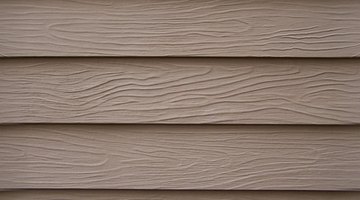How to Build a Pole Barn With Vinyl Siding
Pole barns are cheap and easy alternatives to more traditional barn models. While most pole barns are built with metal or plywood siding, vinyl siding also can be used. Vinyl siding is easy to install and does not rust or rot as other types of siding do. It never needs to be painted, sanded or refurbished, and provides a durable and economical exterior that will protect your pole barn for years.
Preparation

Step 1
Choose a site for your pole barn. Select an area that is relatively level and will remain dry throughout the year. Check with local utility companies to ensure that the project will not interfere with any underground utility lines.
Step 2
Check with local building department officials to find out whether the project will require a permit. Many municipalities require building permits for all new structures.
Step 3
Grade the building site and align the corners to guarantee that the plot is perfectly square. Small errors can have big consequences at later stages of the project.
Building the Barn
Step 1
Dig post holes at the corners, and at 12-foot intervals along each side of the barn. The holes should be at least two-feet deep.
Step 2
Insert the 4-by-4 posts, pouring 6 inches of concrete around the foot of each post. Allow the concrete to set, keeping the posts braced and level. Then fill the holes with gravel or soil and pack down firmly.
Step 3
Use 2-by-4 lumber to create a basic framework for the poles. Nail three crossbars between each pair of posts: one at the bottom, one at the top, and one in the center.
Step 4
Erect the poles, aligning them vertically and nailing them to the outside of the 2-by-4 crossbars.
Step 5
Attach another set of 2-by-4 boards along the top of the poles to support the roof trusses. Check that the boards are level and nail them securely.
Step 6
Hang the trusses. The safest approach is to use a backhoe or other construction equipment, as the trusses are heavy and can tip easily during the installation process. Attach each truss to the 2-by-4 supports. Trusses should be placed at four-foot intervals.
Step 7
Nail 2-by-4 boards across the top of the trusses to make a framework for the roofing. Attach the boards at two-foot intervals across the entire roof.
Step 8
Install the metal roofing, overlapping the sheets by at least 6 inches and allowing for a slight overhang above the eaves.
Step 9
Secure galvanized ridge cap along the ridge line, overlapping sheets by about 12 inches.
Installing the Siding
Step 1
Nail up another set of 2-by-4 crossbars along the sides of the barn, creating a framework for attaching the plywood backing.
Step 2
Install plywood backing or foam board insulation. Since vinyl siding is more flexible than metal siding, it cannot provide enough structure without additional bracing.
Step 3
Use a chalk line to mark the placement of the crossbars, so that you will know where to align the nails.
Step 4
Attach siding starter strips at the top and bottom of each wall.
Step 5
Put up the siding one sheet at a time, starting at the bottom and working your way up to the top. Vinyl siding works on a snap-lock system with each piece sliding into the channel and snapping into place after the previous piece. Slide in each sheet and nail it in, nailing loosely so that there is a 1/16-inch gap between the vinyl and the head of the nail. This will allow the siding some flexibility, so that it will not buckle under intense sunlight.
References
Resources
Writer Bio
Ann Pedtke has been writing about science and the environment since 2001. Her work has appeared in "Isotope," "Green Prints," "The Hudson River Almanac," "The Conservationist" and other publications. Pedtke holds a Bachelor of Arts in English from Kenyon College and works in environmental education in New York City.
Photo Credits
- house siding 3 image by Psycience from Fotolia.com
More Articles



